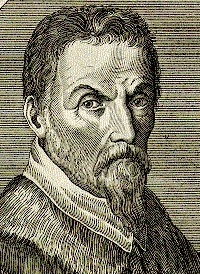Cesare Cremonini (philosopher) facts for kids
Quick facts for kids
Cesare Cremonini
|
|
|---|---|
 |
|
| Born | 22 December 1550 |
| Died | 19 July 1631 (aged 80) |
| Era | Renaissance philosophy |
| Region | Western philosophy |
| School | Aristotelianism Averroism Scholasticism |
|
Main interests
|
Metaphysics, astronomy, medicine |
|
Notable ideas
|
Mortality of the soul, separation of reason and faith |
|
Influences
|
|
|
Influenced
|
|
Cesare Cremonini (Italian: [ˈtʃeːzare kremoˈniːni, ˈtʃɛː-]; 22 December 1550 – 19 July 1631), sometimes Cesare Cremonino, was an Italian professor of natural philosophy, working rationalism (against revelation) and Aristotelian materialism (against the dualist immortality of the soul) inside scholasticism. His Latinized name was Cæsar Cremoninus or Cæsar Cremonius.
Considered one of the greatest philosophers in his time, patronized by Alfonso II d'Este, Duke of Ferrara, corresponding with kings and princes who had his portrait, paid twice the salary of Galileo Galilei, he is now more remembered as an infamous side actor of the Galileo affair, being one of the two scholars who refused to look through Galileo's telescope. What is often not remembered is that "Cremonini’s reason for not trusting the telescope was that he had looked through one. The image confused and dizzied him. He inferred that only people with quirky eyesight and unrestrained imagination could see what Galileo had claimed to see."
Biography
Cesare Cremonini was born in Cento in the then Papal States. He was a professor of natural philosophy for about 60 years:
- From 1573 to 1590, at the University of Ferrara. Starting at a very young age and considered a great talent, he obtained the patronage of Alfonso II d'Este, Duke of Ferrara (to whom he would dedicate his first major book in 1596). The jealousies caused by this protection helped him to eventually accept a position outside his native province.
- From 1591 until his death, at the University of Padua in Padua, then under Republic of Venice rule (succeeding to Jacopo Zabarella), in a chair of natural philosophy and a chair of medicine.
He taught the doctrines of Aristotle, especially as interpreted by Alexander of Aphrodisias and Averroes.
He was so popular in his time that most kings and princes had his portrait and corresponded with him, sometimes consulting him about private and public affairs. At Padua, his salary was twice that of Galileo. He was especially popular among the French intellectuals who called him "le Cremonin" (the Cremonin); even a remote writer such as Jean-Louis Guez de Balzac mentioned him as "le grand Cremonin" (the great Cremonin) in his Lettres.
Cremonini and Galileo
At Padua, Cremonini was both a rival and a friend of his colleague Galileo. When Galileo announced that he had discovered mountains on the Moon in 1610, he offered Cremonini the chance to observe the evidence through a telescope. Cremonini refused even to look through the telescope and insisted that Aristotle had definitely proved the Moon could only be a perfect sphere. When Galileo decided to move to Tuscany that year, Cremonini warned him that it would bring him under the Inquisition's jurisdiction. Indeed, the next year the Inquisition reviewed Cremonini's case for evidence against Galileo. Years later, in his book Dialogue Concerning the Two Chief World Systems, Galileo would include the character Simplicio - the name was not casually chosen - a dogmatic Aristotelian philosopher who was partly based on Cremonini.
Death and legacy
When Cremonini died in 1631 during the Paduan outbreak of the Italian Plague of 1629-1631, more than 400 students were working with him. His previous students included, alphabetically:
- Theophilos Corydalleus, graduated 1613, a Greek philosopher, had some influence in the Greek-speaking world during the 17th and 18th centuries, founded Corydalism
- William Harvey, graduated 1602, an English doctor who was the first to correctly describe the circulation of the blood
- Joachim Jung, graduated 1619, a German mathematician and naturalist popularized by John Ray
- Ioannis Kottounios, an eminent Greek scholar and his successor to the chair of philosophy at Padua
- Justus Lipsius, a philosopher of the Spanish Netherlands
- Gabriel Naudé, in 1625–27, a French scholar and Cardinal Mazarin's librarian
- Guy Patin, a French doctor, headmaster of the School of Medicine in Paris
- Antonio Rocco, an Italian philosophy teacher and libertine writer
- Corfitz Ulfeldt, in 1628–29, a famous Danish statesman and traitor
- Flemming Ulfeldt, also in 1628–29, a Danish statesman and military leader, younger brother of Corfitz
He was buried in the Benedictine monastery of St. Justina of Padua (to which he also willed his possessions). His name has been given to several streets ("via Cesare Cremonini" in Cento, "via Cesare Cremonino" in Padua) and an institute ("Istituto Magistrale Cesare Cremonini" in Cento).

